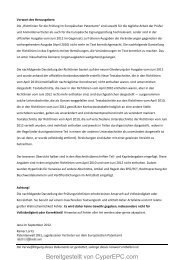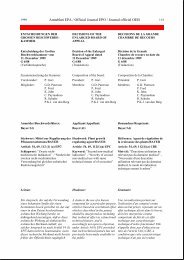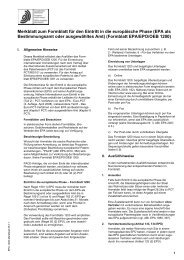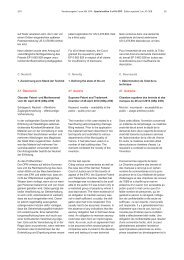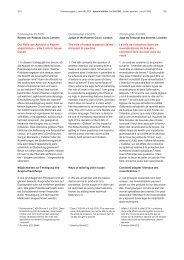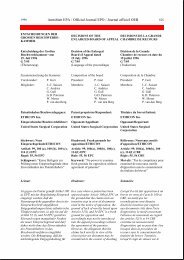Sonderausgabe 3 zum ABl. EPA 2011/107 - CyberEPC
Sonderausgabe 3 zum ABl. EPA 2011/107 - CyberEPC
Sonderausgabe 3 zum ABl. EPA 2011/107 - CyberEPC
Create successful ePaper yourself
Turn your PDF publications into a flip-book with our unique Google optimized e-Paper software.
114 <strong>Sonderausgabe</strong> 3 <strong>zum</strong> <strong>ABl</strong>. <strong>EPA</strong> Special edition 3 of OJ EPO Edition spéciale 3 du JO OEB <strong>2011</strong>cher in der Berufung angeführten Entgegenhaltungenzu prüfen.Angesichts der Aufgaben, die sich demFachmann stellten (nämlich sicherzustellen,dass das zusammengesetzte Gerätwasserdicht und sehr robust war), sahsich dieser durch keine der früherenLehren dazu veranlasst, ganz selbstverständlichin Richtung eines Zusammenwirkensdes Griffs und des die Befestigungsmittelumfassenden Teils zuforschen, von denen jedes eine andereFunktion erfüllte. Er wurde ganz imGegenteil durch die Entgegenhaltungenveranlasst, zu denken, dass die Verbindungdurch Umspritzen der Metallteilemit Kunststoff und somit durch Einführungvon Materie, welche die Drähtefest umschloss und so daran hinderte,sich in Längsrichtung oder rotierend zuverschieben, ausreichte, um das angestrebteErgebnis zu erzielen, das jedochin Wirklichkeit nur unvollkommen ausfiel.The Court ruled that in view of theproblems for which the skilled personsought a solution (ensuring the tightnessand high-level stability of the wholeimplement), none of the prior-art teachingswould lead the skilled person toregard it as obvious for there to be cooperationbetween the handle and thesub-assembly comprising attachmentmeans each guaranteeing distinct functions;on the contrary, the prior art wouldlead him to think that fixing by duplicatemoulding, i.e. introducing materialresulting in a clasping of the wires,thereby preventing them from movinglongitudinally and from rotating, wasenough to achieve the desired result, aresult which proved to be imperfect inpractice.défaut d'activité inventive au regard del'ensemble des documents opposés enappel.La Cour juge que, devant les problèmesauxquels l'homme du métier souhaitaitapporter une solution (assurer l'étanchéitéet une grande solidité de l'ensemble),aucun des enseignementsantérieurs ne conduisait l'homme dumétier à aller avec évidence dans lesens d'une coopération entre le mancheet le sous-ensemble comportant desmoyens d'ancrage assurant chacun desfonctions distinctes ; au contraire, lesantériorités le conduisaient à penser quela solidarisation par surmoulage et doncpar l'introduction de la matière ayantpour résultat d'enserrer les fils et ainside les empêcher de bouger tant longitudinalementqu'en rotation était suffisantepour assurer le résultat recherché, résultatqui, en réalité, n'était pas parfait.FR FrankreichKassationsgerichtshof vom26. Februar 2008 (06-19149) –Newmat v. NormaluSchlagwort: erfinderische Tätigkeit –Fachmann – benachbartes GebietDas Berufungsgericht hatte Anspruch 1eines Patents auf "ein profiliertes Teil<strong>zum</strong> Aufhängen einer Spanndecke" mitder Begründung für nichtig erklärt, dieDruckschrift Peillex sei zwar nicht unmittelbarauf Spanndecken anwendbar,beziehe sich jedoch auf Verbindungenzwischen Mauern und Decken, mitdenen sich diese abdichten ließen, wasbedeute, dass diese Verbindungen denZweck hätten, keine Zwischenräumezwischen den anderen Elementen zulassen; der Fachmann (hier: für Zwischendecken)könne die verschiedenenzur Herstellung der Verbindung zwischenMauern und Decken vorgesehenenStrukturen nicht außer Betracht lassen,und die Behauptung, es sei nicht möglich,sich auf die Lehre des DokumentsPeillex zu beziehen, sei daher zurückzuweisen.Der Kassationsgerichtshof führte aus,dass der Fachmann derjenige ist, derüber das normale Fachwissen auf dembetreffenden Gebiet verfügt und in derFR FranceCourt of Cassation of 26 February 2008(06-19149) – Newmat v NormaluKeyword: inventive step – skilledperson – neighbouring fieldIn revoking claim 1 of a patent relatingto "a shaped part to affix to a stretchceiling" for lack of inventive step, theappellate court held that a document("Pelleix") did not relate directly to stretchceilings. Nevertheless, it did concernconnections between walls and ceilingsthat were designed to ensure tautness,such connections serving to eliminateany gaps between the other parts, andsince the person skilled in the art offalse ceilings could not be unaware ofthe different structures envisaged forconnecting walls and ceilings, the argumentthat it was not possible to refer tothe teaching of the Peillex document hadto be dismissed.The Court of Cassation ruled that theskilled person was someone who had anormal knowledge of the technology inquestion and was able, relying solely onFR FranceCour de cassation du 26 février 2008(06–19149) – Newmat c. NormaluMot-clé : activité inventive – hommedu métier – domaine voisinLa Cour d'appel, pour annuler, fauted'activité inventive, la revendication 1d'un brevet couvrant "une pièce profiléepour l'accrochage d'un plafond tendu",avait relevé que le document Peillexne s'appliquait pas directement à desplafonds tendus, mais que comme ilportait sur des liaisons entre murs etplafonds permettant d'assurer uneétanchéité, ce qui signifiait que ces liaisonsavaient pour but de ne pas laisserd'interstice entre les autres éléments,l'homme du métier, c'est-à-dire celuides faux plafonds, ne pouvait ignorerles différentes structures prévues pourassurer des liaisons entre murs etplafonds, et que, dès lors, l'argumentationselon laquelle il n'était paspossible de se référer à l'enseignementdu document Peillex devait être écartée.La Cour de cassation énonce quel'homme du métier est celui qui possèdeles connaissances normales de latechnique en cause et est capable, à



